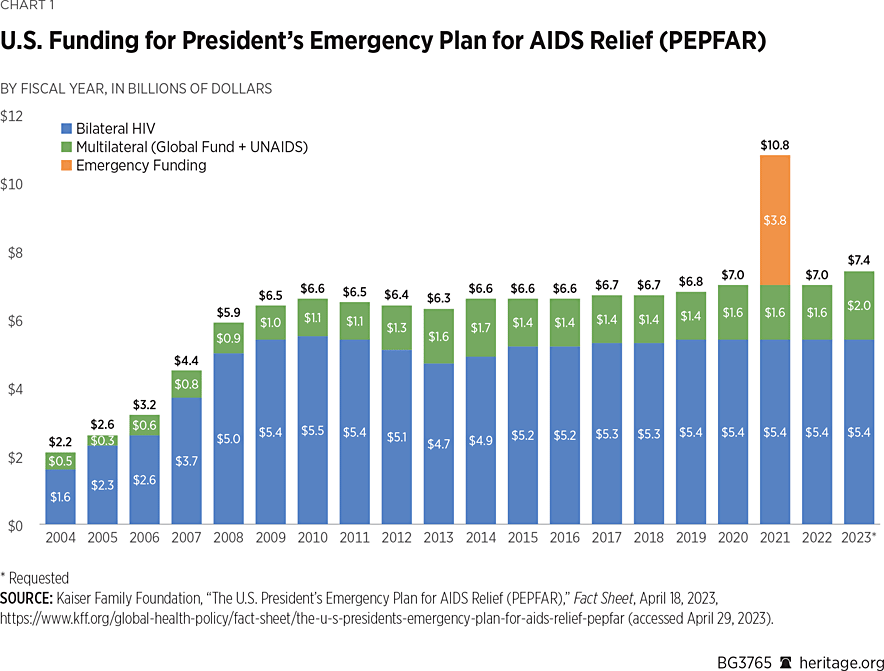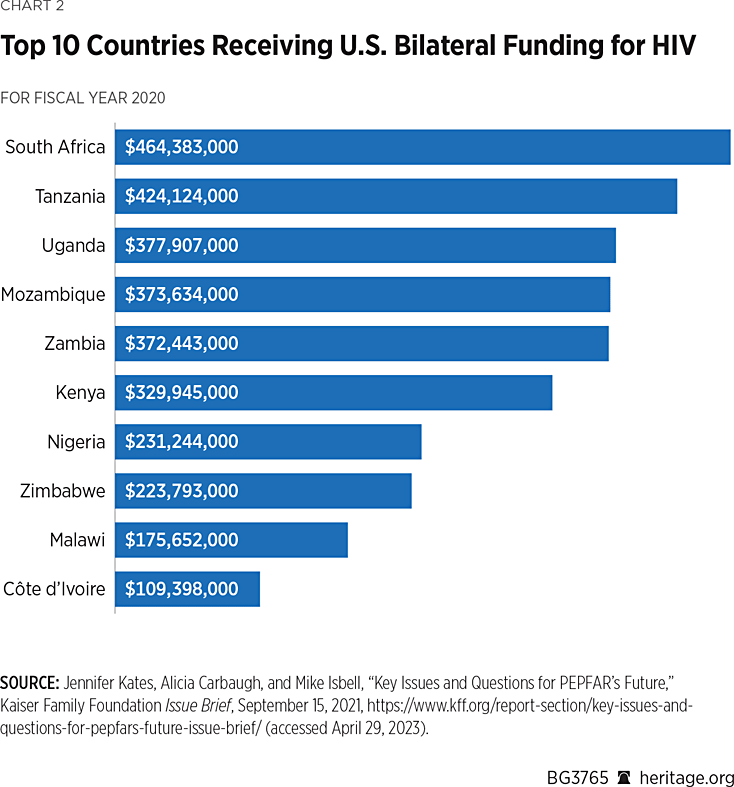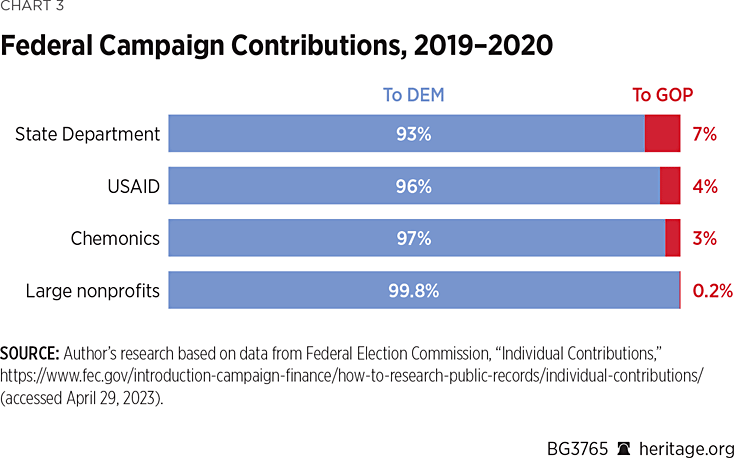The President’s Emergency Plan for AIDS Relief (PEPFAR) was established as a five-year plan by President George W. Bush in 2003 to address an epidemic ravaging Africa and other parts of the world. It celebrated its 20th anniversary in January 2023. Initially envisioned as an “emergency” program, PEPFAR confirms the old adage that there is nothing more permanent than a temporary government program. The program is currently up for five-year renewal in the U.S. Congress and another $30 billion in funding.
The program is credited with saving an estimated 25 million lives and is a tribute to the American people’s unparalleled charitable spirit in helping others who are in need. A deeper dive into the program, however, suggests weaknesses within its structure and approach that increasingly have limited its impact and have begun to have harmful effects. The program was founded on conditions and assumptions that existed two decades ago, and it is questionable that the original rationale for the “emergency” response of 2003 is still applicable in 2023. Yet the program continues largely unchanged. Worse, the Biden Administration has misused PEPFAR, as it has used all of its other foreign aid programs, as a well-funded vehicle to promote its domestic radical social agenda overseas.REF
To increase its effectiveness, PEPFAR should be redesigned to transition it toward more country ownership and co-financing. It should be restructured as a development rather than an emergency assistance program and, to recognize its transition from an “emergency” program, renamed the George W. Bush Global Health Initiative to honor its founder.
Development vs. Emergency Assistance
PEPFAR is the most expensive foreign assistance program in history with average annual funding for bilateral programs totaling more than $5 billion, and total funding through 2022 (including multilateral funding) of more than $110 billion.REF PEPFAR alone makes up the majority of U.S. global health funding: from 56 percent to 62 percent over the past five years.REF In 2021 alone, Congress provided PEPFAR almost $11 billion in funding. (See Chart 1.) The massive scale of this funding and the ongoing lack of significant oversight or audits raise serious concern with respect to the effective absorptive capacity of target countries and the potential for waste, fraud, and abuse of taxpayer funds.
PEPFAR is managed by the U.S. Department of State, whose primary responsibility is diplomacy, rather than the U. S. Agency for International Development (USAID), which is normally responsible for implementing large and complex foreign aid initiatives. Transitioning PEPFAR from an emergency response initiative under State to a development program under USAID would both shift the primary focus of American resources toward strengthening the capacity of beneficiary countries to take on an increasing share of the responsibility for preventing and treating the disease and decrease the dependence of those countries on external donors.

To date, PEPFAR has focused primarily on U.S.-led service delivery of pharmaceuticals and medical supplies. The weaknesses of this approach have been highlighted since at least 2007, when the Institute of Medicine stated that “[f]or continued progress toward its 5-year targets and longer-term goals, PEPFAR should transition from a focus on emergency relief to an emphasis on the long-term strategic planning and capacity building necessary for sustainability.”REF
Other large health programs like GAVI–The Vaccine Alliance and the Global Fund to Fight AIDS, Tuberculosis and Malaria have programmatic objectives that include fostering sustainability and country ownership, and they have developed and implemented specific graduation criteria and requirements for country co-financing of projects. PEPFAR, on the other hand, has never developed any formal transition or graduation plans for its program countries.
PEPFAR channels much of its assistance through large international organizations, U.S. consulting firms, and non-governmental organizations (NGOs). The top 10 PEPFAR contracting partners in 2022 received 40 percent of total funding. The top four were Chemonics ($710 million); FHI 360 ($207 million); the Columbia University–based ICAP ($153 million); and the Elizabeth Glaser Pediatric AIDS Foundation (EGPAF, $134 million).REF Significant portions of PEPFAR funding over two decades have been used to increase profits and build the capacity of these service providers rather than local health providers. USAID refuses to make public the overhead rates of its partners,REF but past USAID senior officials have said that only “20 percent to 30 percent of funding reaches people in need.”REF
Although AIDS is a global problem, PEPFAR has focused much of its spending on the same few African countries, without any particular correlation to the scale of the problem in those countries, compared to unserved or less-served countries.REF Effective development would mean a decrease in need and a decrease in spending in these countries over time, providing the opportunity to shift resources to other countries; in the case of PEPFAR, however, we see no decrease in spending or reorientation of priorities over time.

Development Approaches
A central tenet of PEPFAR’s initial strategy was an expectation that partner countries would be closely involved in the design and implementation of programs. In practice, PEPFAR relies on programs developed and implemented by U.S.-based organizations and institutions. Although this is considered bad development practice, it makes it easier to deliver services, and the high numbers PEPFAR has generated, compared to those possible through locally led development programs, have been cited as evidence of PEPFAR’s success.REF
Admittedly, it is more efficient for U.S.-based organizations to fund, source, and deliver medicine directly to beneficiaries rather than building local capacity to provide these services. Unfortunately, there are long-term negative consequences associated with this approach that include neocolonialism (the imposition of foreign cultural practices and creation of a patron/client power dynamic between aid providers and recipient countries and beneficiaries) as well as dependence on aid, misallocation of resources, increased costs, and failure to develop indigenous capacity.
PEPFAR has been criticized for its recruitment and employment practices in recipient countries.REF Its well-funded local programs use high salaries to recruit physicians, nurses, and other health care professionals to work exclusively on HIV/AIDS, significantly decreasing the number of skilled medical professionals available for the broader health system and primary care. As a result, some researchers argue, the overall health of these communities decreases.REF
In the global health sector, maldevelopment and dependence create social fragility and increased risk. As local coping mechanisms are supplanted by foreign assistance, populations become more vulnerable and susceptible to unanticipated events. For example, 86 percent of HIV-related support in Tanzania is provided by PEPFAR. Unanticipated geopolitical events like the COVID pandemic could result in a sudden cessation of external aid, leaving countries like Tanzania with no local mechanisms or institutional capacity to raise the resources needed to manage the disease.
Opportunity Costs of Single Disease Service vs. General Health System Strengthening
Some have argued that the amount of assistance directed to HIV/AIDS is inversely proportional to the global burden of the disease.REF Although PEPFAR claims to have saved 25 million lives, could those resources have saved even more lives if they had been distributed proportionally based on disease severity? Did the focus on just one disease in a few countries, rather than strengthening health systems and primary care, mean higher mortality rates for other diseases and countries?
With 60 percent of all U.S. health assistance going to PEPFAR, these resources are unavailable for other health investments in developing countries that might have even greater impact on local health. For example, diarrheal diseases kill more people in Africa than HIV/AIDS kills, and they can be prevented through cost-effective programs that increase access to clean water.REF
Political Concerns
Although created by a Republican President, and despite generally receiving bipartisan support in Congress, PEPFAR has always been controversial. Except in cases of rape or maternal transmission, HIV/AIDS in the U.S. and in developing countries is primarily a lifestyle disease (like those caused by tobacco) and as such should be suppressed though education, moral suasion, and legal sanctions. For conservatives committed to personal responsibility, it also should not enjoy greater priority than deadlier and more unavoidable diseases receive in the allocation of public funds.
Early in the program, Republicans argued that, as with any venereal disease, education and abstinence could end the AIDS epidemic; Democrats argued that condoms and antiretrovirals were the answer and that expecting populations to change their behavior was a form of colonialism. Although abstinence has been stripped from PEPFAR programs, Democrats have now added—in a practice decried by locals as neocolonialism—their own social priorities like abortion and promotion of LGBTI issues.
The Biden Administration has openly tied promotion of abortion and the LGBTI agenda to U.S. foreign aid programs. On January 28, 2021, President Biden issued a memorandum “to support women’s and girls’ sexual and reproductive health and rights in the United States, as well as globally.”REF On June 30, 2021, the Biden Administration announced that it was “reasserting U.S. leadership on gender equity and equality on the world stage” and advancing “sexual and reproductive health services in Haiti and 14 African countries”REF by resuming funding for the U.N. Population Fund. The following year, USAID funded a consortium that includes the International Planned Parenthood Federation with a contract worth $38 million to support health activities in Africa, including activities to combat HIV/AIDS.REF
On the Left, “sexual and reproductive rights” and “reproductive health services” are code for abortion. After Roe v. Wade was overturned, PEPFAR’s second largest recipient expressed its support for “equal access to reproductive health services, including safe and legal abortion care,”REF and its fifth largest partner stated that the overturning of Roe v. Wade was “undermining what Jhpiego has been working towards since our founding”REF even though the Helms Amendment specifies that foreign aid shall not “be used to pay for the performance of abortions as a method of family planning or to motivate or coerce any person to practice abortions.”REF
Political contribution analysis explains why the supposedly neutral and nonpartisan development agencies and government-funded development contractors and NGOs all seem to promote a leftist agenda even when that agenda comes at the expense of the overall health of the marginalized beneficiaries of our foreign assistance. Almost all political contributions from employees of PEPFAR agencies and assistance providers have gone to Democratic candidates and causes, revealing that PEPFAR is in fact an entirely Democrat-run program.
In the U.S., where elections suggest that citizens are split more or less evenly between the parties, such a massive disparity in political contributions is likely the result of systemic and institutionalized discrimination against Republicans in hiring, fear on the part of Republican employees that revealing their political affiliation would result in workplace harassment and persecution, or both. The following is a summary of the findings on campaign donations from the State Department, USAID, and the top four recipients of PEPFAR funding.
Federal Campaign Contributions from State Department Employees 2019–2020. Among State Department employees (excluding political appointees), 4,174 unique individuals made 46,000 separate donations for a total of $2,411,283. Of those donations, about 44,000 went to Democratic candidates and PACs, and about 2,000 went to Republican candidates and PACs. Total dollars donated were about $175,000 (7 percent) to Republican candidates or PACs and about $2,236,000 (93 percent) to Democratic candidates or PACs.

Federal Campaign Contributions from USAID Employees 2019–2020. During this period, 1,051 USAID employees (excluding political appointees) made 13,100 individual political contributions totaling $655,000. Of those employees, 1,001 contributed to Democratic candidates or PACs, and 32 contributed to Republican candidates or PACs. Total dollars donated were about $24,000 (4 percent) to Republicans and about $631,000 (96 percent) to Democrats.
Federal Campaign Contributions from Chemonics Employees 2019–2020. Chemonics, a for-profit consulting firm, is the largest recipient of PEPFAR funding (over $709 million in 2022). During 2019–2020, 375 employees donated an average of $400 each to federal campaigns and PACs for a total of $149,941: $145,316 to Democrats and $4,625 to Republicans. The Republican donations came from just six of the 375 employees, one of whom was an Executive Vice President who donated $1,000 to Republicans but also $1,000 to Democrats.
Federal Campaign Contributions from PEPFAR’s Three Largest Nonprofit Partners 2019–2020. FHI 360, ICAP, and EGPAF are the largest nonprofit recipients of PEPFAR funding. Together, they received over $494 million from PEPFAR in 2022. During 2019–2020, 302 employees from these three nonprofits donated an average of about $500 each to federal campaigns and PACs for a total of $148,906: $148,644 to Democrats and $262 to Republicans. Just two of the 302 employees donated to Republicans.
In Africa there is a saying: “When the elephants fight, it is the grass that suffers.” The ongoing attempt to repurpose PEPFAR into a tool for the promotion of alien ideologies has trampled underfoot the people and countries that were meant to be PEPFAR’s beneficiaries. Conservatives have a moral obligation to American taxpayers to refocus and reform PEPFAR so that it is less a subsidy program for massive contractors and NGOs (and less a patronage program for clients of the Democratic Party) and more focused on the needs of the truly marginalized.
What Legislators and Policymakers Should Do
- Before providing further funding to PEPFAR, Members of Congress should request that PEPFAR provide an explanation for the apparent political discrimination in hiring by these agencies and organizations and a plan to redress the imbalance.
- Transition this 20-year emergency program into a development program focused on developing sustainable heath systems and the prevention and treatment of infectious diseases, including HIV/AIDS. This can limit both the growing dependence on aid and the internal brain drain of health professionals and result in more lives saved. USAID should use appropriated funds to support this transition.
- To ensure gradual country ownership of this transition, the Office of Global AIDS Coordinator and Health Diplomacy should ensure that national governments and other PEPFAR recipients, such as the Global Fund, finance an increasing share of the costs of the drugs PEPFAR purchases. This should amount to 10 percent of the total over each of the next five years, and funding for PEPFAR should be correspondingly reduced by 10 percent for each of the next five years.
- Congress should resist the Biden Administration’s effort to poison bipartisan support for PEPFAR by misusing it to promote abortion under the guise of sexual and reproductive health and transgenderism. This politicizes what has been a targeted and bipartisan health program, disrespects the traditional values of the communities we support, and stokes anti-Americanism with negative foreign policy implications in places where Communist China seeks to displace American influence and power. Congress should make PEPFAR prevention activities subject to the Protecting Life and Global Health Assistance policyREF and hold further funding until that provision is included in the bill.
- In recognition of its transition from a short-term emergency initiative to a longer-term development program, Congress should consider shifting PEPFAR management from the U.S. Department of State to USAID and, to honor the founder of PEPFAR, change its name to the George W. Bush Global Health Initiative.
Tim Meisburger is a Visiting Fellow in the Douglas and Sarah Allison Center for Foreign Policy Studies at The Heritage Foundation. He has more than 35 years of democracy and development experience with the U.S. Agency for International Development, Asia Foundation, Peace Corps, and United Nations agencies in Asia, Africa, and Eastern Europe.


